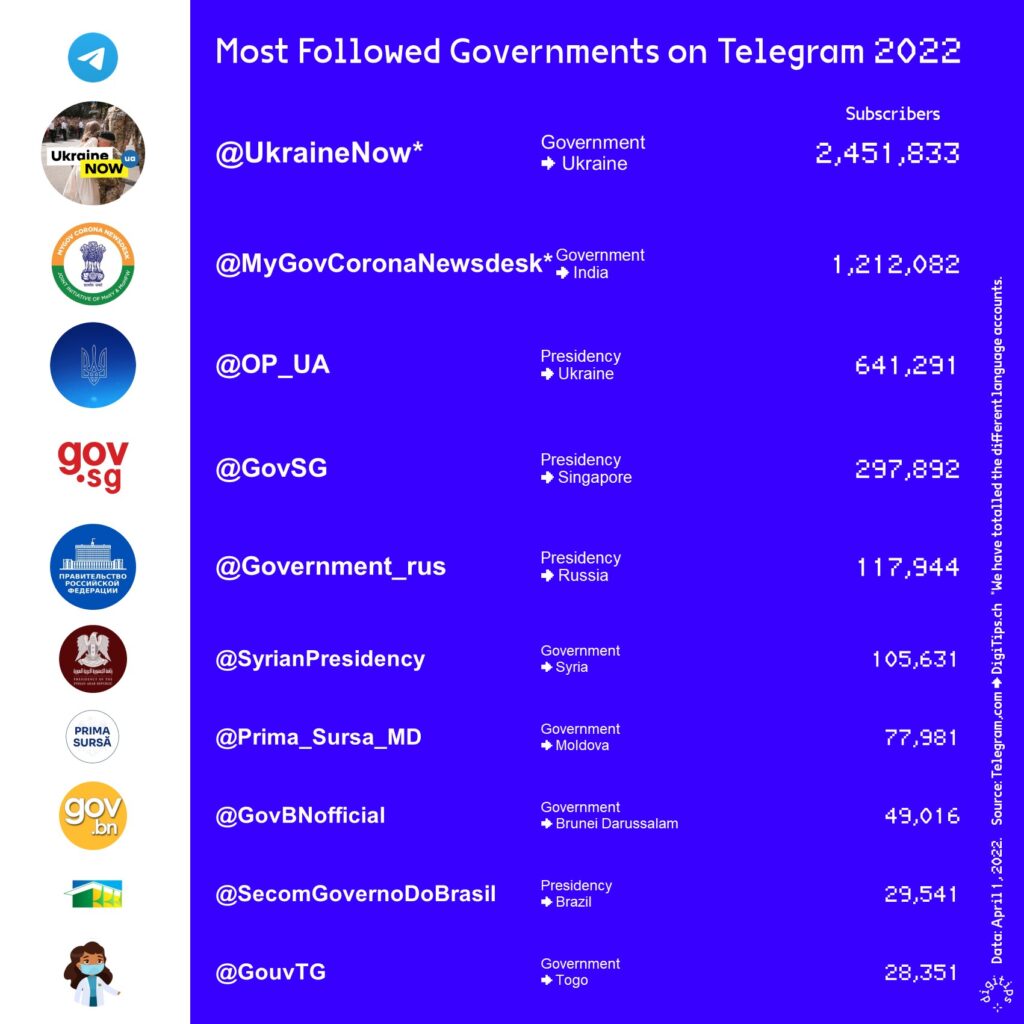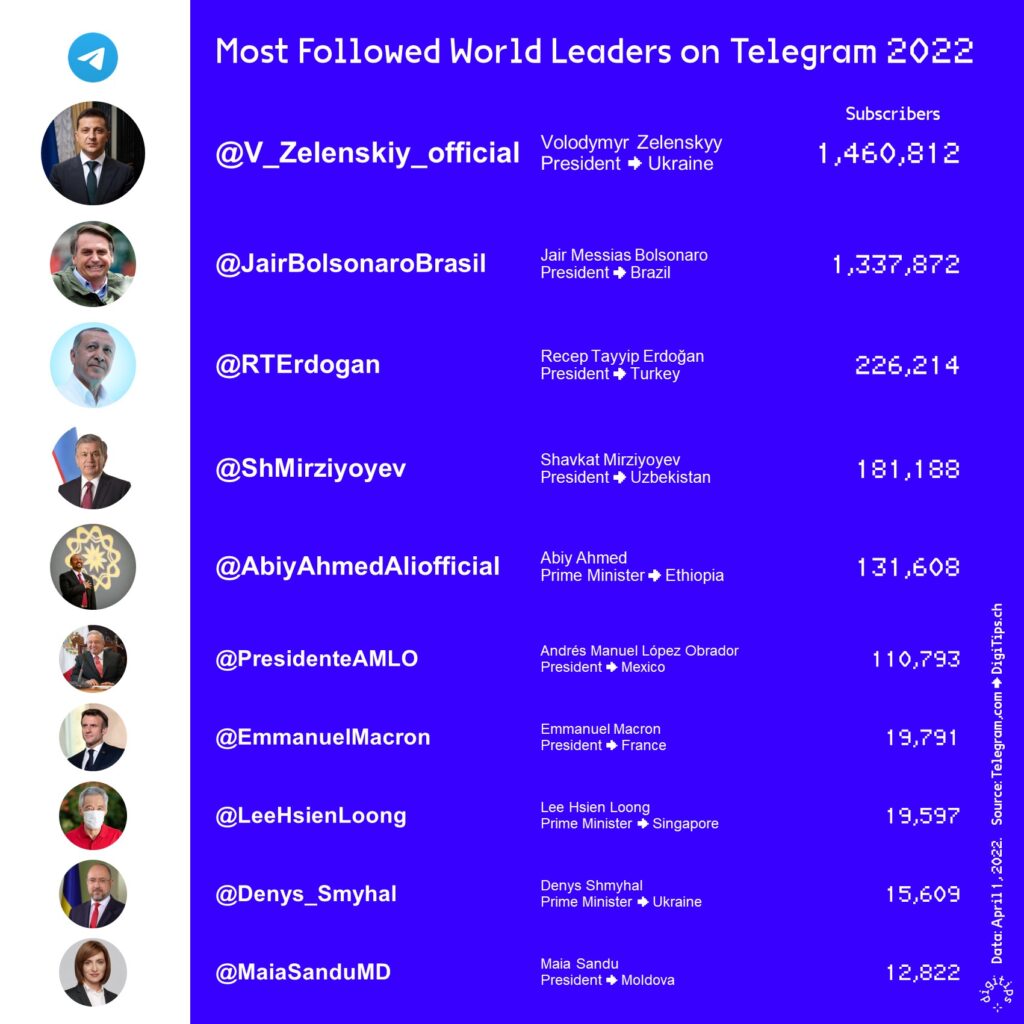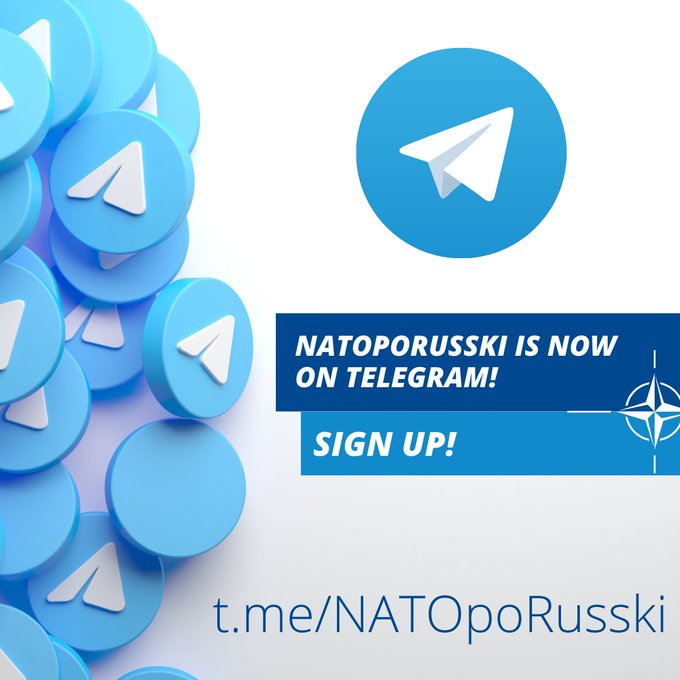World Leaders, War & Digital Diplomacy on Telegram
An increasing number of governments, foreign ministries and world leaders are signing up to Telegram one of the last remaining social media platforms accessible in Russia.
Telegram has become the frontline in the information war between Russia and Ukraine.
It is on Telegram that Ukrainian President Volodymyr Zelenskyy dressed in military fatigue, posts his daily video messages, encouraging his citizens to #StopRussianAgression.
It is also the platform where Chechen leader Ramzan Kadyrov, lends support to his troops on the ground in Ukraine from the comfort of his gilded office in Grozny.
Thousands of Ukrainians have flocked to the platform for the latest official government news about the war; Russians have massively migrated to the app after the ban of Facebook, Instagram, and Twitter in their country.
Since Telegram is the last open window into Russia, NATO and a handful of foreign ministries have opened Telegram channels over the past month in the hope of reaching ordinary Russians.
Western media outlets, namely The New York Times, The Washington Post, and The Guardian have activated or re-activated their Telegram channels to offer Russian users an alternative perspective to the official government propaganda.
And finally, foreigners are signing up in droves to follow the war in Ukraine live as reported by the key actors. Telegram has reported an average of 2.5 million new users daily in the last three weeks, a 25% increase from the weeks prior.
Contrary to WhatsApp, which is less suited for mass communication, Telegram allows users to create groups with up to 200,000 users and set up public channels.
Initially Telegram founder Pavel Durov considered blocking Telegram in the warring countries given Telegram channels and groups are often used to spread disinformation; it is also physically impossible to confirm the veracity of each publication. But after massive pressure from users he decided against the closure.
The messaging app, which has more than 550 million monthly users globally, is widely popular in Russia with 67 million users or 65% of all internet users in the country according to data from eMarketer. It is reportedly the most popular messaging service in Ukraine. The adoption of the messaging apps Telegram and Signal has surged by almost 200% in both Russia and Ukraine since the beginning of Russia’s invasion according to a report by market intelligence firm Sensor Tower.
With the ban of Facebook, Instagram and Twitter in Russia, tens of thousands of Russians have moved over to Telegram which is still freely available in Russia. Reuters reported on March 21 that Telegram had overtaken WhatsApp to become Russia’s most popular messaging tool.
Telegram is especially popular in the countries of the former Soviet Union, namely Kazakhstan, Kyrgyzstan, Moldova, Ukraine, and Uzbekistan. It comes as no surprise that the governments in these countries maintain active channels on the platform.
Russian authorities have embraced the messaging app, which was created in 2013 by Russian entrepreneur Pavel Durov, the founder of VKontakte (VK), Russia’s Facebook clone.
In 2018 the Russian government attempted to block Telegram for not cooperating and handing user data to the Russian security services. However, the ban was ineffective and was lifted in summer 2020. Even the Russian Foreign Ministry posted on the platform during the ban. Given the Russian government and many ministries maintain public channels on the platform, experts believe it is unlikely that Russia will ban Telegram which has been dubbed ‘the last app standing’.
Digital Diplomacy on Telegram
Telegram has been part of the Russian digital diplomacy toolkit since 2016. The Foreign Ministry created its official Russian and English channels @MID_Russia and @MFARussia on November 1, 2016.
In March 2022 both channels grew exponentially, doubling and quadrupling their subscriber numbers which now stand at 102,234 and 19,367 respectively. At the same time the Foreign Ministry in Moscow set up separate channels in Arabic and Spanish, becoming the leading foreign ministry on the platform to total 127,000 subscribers on all four channels. However, that number pales compared to the 321,280 subscribers of the personal channel of Russian Foreign Ministry spokeswoman @MariaVladimirovnaZakharova.

The Foreign Ministry of Israel is the second most followed foreign ministry on Telegram with more than 53,000 subscribers on its Russian, English, and Farsi channels; @IsraelinRussian is its most followed channel.
The Telegram channel of the Ukrainian Foreign Ministry @Ukraine_MFA was initially set up in March 2020 to spread information about the coronavirus pandemic, but it has since changed tack to share “information about the Russian invasion and the operational situation on the diplomatic front”. It is in fourth place of the most followed foreign ministries with more than 16,000 subscribers.
The U.S. State Department was an early adopter of Telegram when it created an official channel in Farsi on December 4, 2015, to counter the ISIS narrative under the Obama administration. However, the channel @USAdarFarsi which still has 14,709 subscribers, was mothballed in December 2021: it asked its community to follow @USAbehFarsi on Instagram, Facebook, and Twitter instead to receive “the latest news and cultural content about the USA”.
The foreign ministries of Armenia, Iraq, Uzbekistan, Singapore, Kazakhstan, and Moldova complete the top 10 list of the 28 foreign ministries on the platform.
How do you reach the Russian population in Russia?
On February 27, three days after Russia’s attack on Ukraine the State Department created a bespoke Russian-language channel on Telegram @USApoRusski. It only has 2,159 subscribers.
The EU External Action Service followed suit on March 2 with a video from the EU’s Foreign Policy Chief Josef Borrel on the @EUinRU channel managed by the EU Mission in Moscow: “We know that millions of Russians do not want war. And I sincerely wish your leader stop this fratricidal war.”
“We must keep communication channels open”, said EU External Affairs spokesperson Peter Stano via email of the decision to create a Telegram channel. “Since the Kremlin imposed heavy restrictions on most of the social platforms and international media, which are not accessible in Russia anymore (Facebook, Twitter, and Instagram), Telegram seems to be one of the very few remaining and accessible channels”, he added. In short succession foreign ministries from the leading G7 countries took to Telegram to stay in touch with Russia’s social media users.
The French Foreign Ministry launched its bilingual French and Russian channel @FranceDiplomatie on March 11, the @EuropeanCommission created its channel on March 23 and the German Foreign Ministry tasked its Embassy in Moscow with the creation of the @Germania_Online channel on March 24. In a service tweet in Russian the German Foreign Ministry explained the purpose of the account: “to continue to provide our subscribers in Russia with factual information.”
The European Commission promised: “regular EU updates on our latest announcements, our support to Ukraine, our sanctions against Russia and our practical information for refugees.”
Within the first week of operation the EU Commission shared 54 posts mainly in English and a few in Ukrainian to its 2,321 subscribers.
NATO has become the latest international organization to set up shop on Telegram on March 4. @NATOpoRusski fired its first Russian-language post on March 12, promising: “the truth about our activities, deployments, summits and more.”
NATO’s counterpart, the Collective Security Treaty Organization (CSTO), a military alliance comprising Armenia, Belarus, Kazakhstan, Kyrgyzstan, Russia, and Tajikistan started their Telegram channel on January 12, 2022, with the announcement of an extraordinary meeting of the CSTO Council of Defence Ministers to discuss the peacekeeping operation in Kazakhstan. The @ODKB_CSTO channel has close to 6,000 subscribers.
Few international organisations have set up shop on Telegram. Human Rights Watch maintains channels in Chinese, English, and Russian since early 2018 but with few subscribers. The World Economic Forum which has always been leading on social media, has been sharing its popular videos since June 2018 with an audience of 2,365 subscribers.
Dr Tedros Adhanom Ghebreyesus, the Director General of the World Health Organisation (WHO) opened his personal Telegram channel on March 24 and within a week it had almost 1,600 subscribers.
Probably one of the most impactful uses of Telegram was the arrival of Arnold Schwarzenegger on the platform @AASchwarzenegger. The Austrian bodybuilder, American actor and former Governor of California shared a very personal and heartfelt 10-minute-long video message to his “Dear Russian friends”. Speaking about his affection and respect for the people of Russia he compared his father’s fight in the Wehrmacht during the siege of Leningrad in WWII to Russia’s war in Ukraine. “When my father arrived in Leningrad he was all pumped up on the lies of his government. And when he left Leningrad, he was broken, physically and mentally. He lived the rest of his life in pain”, he said.
The Russian Ministry of Defence has been active on the social media platform since December 10, 2016, and the @MoD_Russia channel counts 175,000 subscribers. On March 5, it added an English language channel for foreign audiences @MoD_Russia_en with 41,000 followers.
The Ukrainian Ministry of Defence only joined Telegram on March 8, 2022, in an attempt to #StopRussia and counter Russian propaganda, but so far it only counts 20,000 subscribers. However, the Ukrainians can count on Mykhailo Fedorov, the Minister of Digital Transformation who is credited with having raised a 300,000 strong IT army of Ukraine, a Telegram channel which aims to take down Russian websites in concerted DDOS attacks.
Governmental Channels on Telegram
At the start of Russia’s aggression, the Ukrainian government repurposed its @COVID19_Ukraine Telegram channel and started to share important information about the war. The Ukrainian-language @UkraineNow channel has 1,186,793 subscribers is available in Russian (1,080,665 subscribers), English (subscribers), French, German, Italian, Spanish, and Polish with a combined number of 2.4 million subscribers making it the biggest government channel on Telegram.
The Indian government has 1.1 million subscribers on its @MyGovCoronaNewsdesk , making it the single largest government channel, set up in March 2020 to provide information about the pandemic.

The Ukrainian presidential administration, which started on Telegram on July 4, 2019 as @OP_UA has become the third most followed government channel on Telegram with more than 640,000 subscribers, almost six times as many as the Russian Government channel @Government_rus which counts 117,944 subscribers. Neither the Kremlin nor Vladimir Putin have an official presence on Telegram.
The Telegram channel of the Singapore government @GovSG was set up on April 1, 2020, to share “updates on the latest information about COVID-19” and two years later it nearly 300,000 subscribers. The @SyrianPresidency has been sharing official photos of meetings of Bashar al-Assad since October 2015 and has over 105,000 subscribers.
On February 24, the day of Russia’s aggression against Ukraine the government of Moldova inaugurated its bilingual Moldovan-Russian Telegram channel aptly entitled: “First source/Original Source” @Prima_Sursa_MD, designed to debunk fake news and urging “the media not to share unconfirmed information.” Telegram is used by the governments in 34 countries. The channels of the governments of Brunei Darussalam, Brazil, and Togo are among the 10 most followed.
World Leaders on Telegram
Ukraine’s President Volodymyr Zelenskyy has become the most followed world leader on Telegram with 1,460,812 subscribers. According to Time Magazine, his channel saw an “explosive growth” from 65,000 followers on February 23 to 1.5 million by mid-March. More recently, his account has been losing followers, but he remains ahead of Brazil’s President Jair Bolsonaro with 1,337,872 subscribers. The Brazilian President is heavily promoting his Telegram channel on Twitter.

Zelenskyy set up his personal Telegram channel @V_Zelenskiy_official on July 30, 2019, two months after becoming president with a post showing himself working out in a gym. Over the past years he has maintained a very personal presence on Telegram, often addressing his community directly from his laptop.
His defiant video-selfie recorded on February 25 late in the evening outside the presidential administration building and surrounded by his leadership team, has become one of his most watched videos with 5.3 million views. Occasionally Zelenskyy speaks in English and even in Russian to address his target audience. His team has started posting subtitled versions of his videos in English for his growing foreign audience.

Turkish President Recep Tayyip Erdoğan, Uzbekistan’s President Shavkat Mirziyoyev and Ethiopia’s Prime Minister Abiy Ahmed complete the Top 5 list of the most followed world leaders. Moldova’s President Maia Sandu makes it into the Top 10 and she is the only female leader on Telegram.
Over the past years some governments have abandoned Telegram. The Italian Foreign Ministry started an Italian language Telegram channel in 2016 but stopped a year later after having shared 3,274 posts and only garnered 627 subscribers.

Telegram is the 10th most used social media platform worldwide, but it is still a nascent app in the world of digital diplomacy and government communications. As of April 1, 2022, the heads of state and government and foreign ministers of 56 countries had a presence on Telegram. DigiTips has identified 121 public Telegram channels of heads of state and government and foreign ministries, 36 of which have been verified.
It is interesting to witness the digital diplomacy activity of international organisations and foreign ministries in recent weeks, adopting a new channel to reach new audiences. As the iron information curtain has descended on Russia it seems the use of Telegram is the only way to reach and connect with the Russian population.
However, two weeks after inception the NATO channel and most foreign ministries have less than 500 subscribers. Reaching the Russian population to change hearts and minds promises to be a long and arduous battle.
For more information about world leaders on Telegram follow @DigiTips on Telegram.










